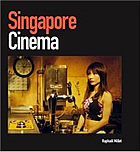BOOK REVIEW:
Mee Pok Man, Money Not Enough, Be
with Me and Singapore
Dreaming. Most Singaporeans would be able to point out
that they are made in Singapore movies and seemly the first
batch of Singapore movies that gave “birth” to
the Singapore Film Industry.
But if you ever wonder those movies were the actual pioneer
batch of Singapore movies, take a look at Singapore Cinema
by Raphael Millet and you will discover that this little red
dot has it’s own uniquely rich Singapore Cinema history
to share.
Covering from the beginning of Singapore Cinema where makeshift
“theatre” comprising of only tents to the latest
films offerings of 2006. Pretty much everything you want to
know about Singapore Cinema (or didn’t even know) is
here in this book.
It recounts the struggles of the pioneers of our local film
distributors, Shaw, Cathay and Eng Wah in the 30s to 40s era.
Businesses were just as competitive as it’s is now.
Barrier to entry was high and these pioneers had to use their
ingenuity to gain entry to this business. Finding their foothold,
it also gave birth to the local Chinese and Malay films production
that we probably never even heard of.
But sadly, when our country gain it’s independence,
factors like the introduction of Television created certain
doom for local film production and giving ways to foreign
films to establish a strong grip in Singapore Cinema. Eventually
Singapore films died of a slow and quiet death in the late
70s.
The revival in recent years, which most of us had witness
began a new era for Singapore film “industry”.
This book covers some of the key persons that played a part
in rejuvenating the once declared “dead” industry
of Singapore. Singapore Cinema tracks a certain selected group
of mavericks that had been largely identified as those behind
the revival. From the commercial successful Jack Neo to those
with more art house appeal such as Royston Tan, Eric Khoo
and a few others who had left their mark in the Singapore
Cinema were all mention in this comprehensive book.
Singapore Cinema is definitely informative and easy to read.
It’s filled with photographs of yesteryears that bring
back a certain sense of nostalgia and for folks like me who
is too young to experience what went on before, these photos
present a portal to the past that I had no idea of. This book
not only reaffirms my faith in the current local films but
interest in what had been done before.
Singapore Cinema is simply one of the best book about the
Singapore film industry .
CHOICE XCERPT:
“Locally made cinema should not fear being too locally
rooted. Many cinemas elsewhere in the world have been successful
by being truly themselves, and having a strong identity. Attempts
at artificial blends so as to be internationally marketable
have been, and are still, even in a globalised world, failures.
No one wants to see a Spanish movie that does not look Spanish.
No one likes a Japanese film trying to look Hollywoodian.
Better to watch a real Hollywood production. And, whatever
one may think, Hollywood is very American, and has never given
up on its Americanness.
And, that is precisely why we like it. As for Singapore cinema,
the more Singaporean it is, the better, I guess… ”
VERDICT:
Like
the Singapore Tourism motto, Singapore Cinema has it’s
uniquely history and True Blue Movie Buff should get this
book or at least read it once to appreciate the journey it
took. It’s embarrassing if you have a wealth of knowledge
on movies around the world except your own backyard.
XTRAS:
Filmography: Extensive coverage of all the feature films that
produced in Singapore and even a listing of foreign movies
that were entirely or partly shot in Singapore or in reference
to Singapore. Sorted out in the year that the film was produced,
the listing includes the runtime, names of the production
crew and some films even come with a brief synopsis.
Accessibility: an informative section on how to get access
to the Shaw and Cathay’s movies from the 1940s to late
1970s period.
   
Review
by Richard Lim Jr
|

